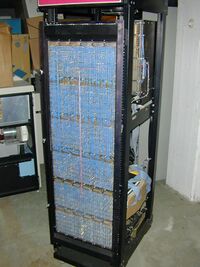Difference between revisions of "CADR"
From Computer History Wiki
(Note descendants; add image) |
(→External links: +one from Paul Allen's collection at the LCM) |
||
| Line 20: | Line 20: | ||
** [https://tumbleweed.nu/lm-3/history.html Lisp Machine System Release History] | ** [https://tumbleweed.nu/lm-3/history.html Lisp Machine System Release History] | ||
** [https://tumbleweed.nu/lm-3/lmman-editions.html Lisp Machine Manual Editions] | ** [https://tumbleweed.nu/lm-3/lmman-editions.html Lisp Machine Manual Editions] | ||
| + | * [https://onlineonly.christies.com/s/firsts-history-computing-paul-g-allen-collection/cadr-lisp-machine-138/230076 CADR LISP machine] - from [[Paul Allen]]'s collection at the [[Living Computer Museum|LCM]], includes several images | ||
* Images | * Images | ||
** [http://www.stupi.se/Bilder/pdp-10/jpg1/dscn2952.jpg CPU backplane] | ** [http://www.stupi.se/Bilder/pdp-10/jpg1/dscn2952.jpg CPU backplane] | ||
Revision as of 16:28, 28 April 2025
The CADR was the first successful LISP machine, built by the MIT AI Lab as a follow-on to the prototype CONS machine. Many were produced by the AI Lab; several startups (including Symbolics and LMI) produced direct descendants.
Physically, the microcoded CPU was a single huge wire-wrap swing-out bay mounted in the front of an H960 rack. A separate backplane held main memory cards, I/O cards, etc.

The Knight keyboard was used with the MIT-AI ITS machine and CADRs; this is a rendition of the layout
External links
- CADR - AI Memo 528
- CADR - Bitsavers
- cadr2/mit/ - much MIT CADR material
- Retrocomputing - MIT CADR Lisp Machines - includes emulator, complete sources, and bootable disk images
- LM-3 --- resurrecting the MIT CADR - contains much interesting historical material, as well as current simulation work
- CADR LISP machine - from Paul Allen's collection at the LCM, includes several images
- Images
